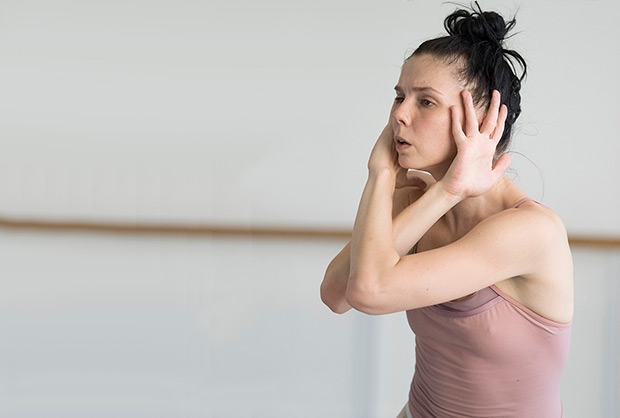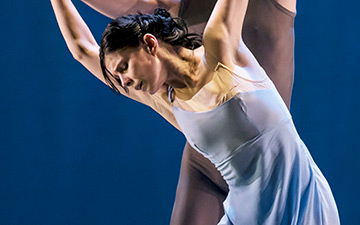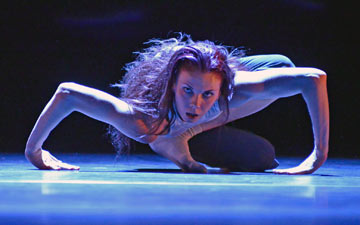
© Alastair Muir. (Click image for larger version)
No trade description problems, here. This was exactly what it said on the tin: Natalia Osipova performing pure dance, enhanced only by recorded music and lighting designs varying from the merest of subtle tints to an explosion of floodlights; seemingly more than would be needed to illuminate a night-time game down the road, at Arsenal. “Set design” was not a line to trouble the budget since the Sadler’s Wells stage was as bare as a new-born baby.

© Rick Guest, stylist Olivia Pomp. (Click image for larger version)
Osipova performed in five (of six) works, essaying a diverse range of dance styles from neoclassical ballet to a variety of contemporary movement. She was comfortable with the differing physical demands of each genre: light, airy and on her toes for one work; and then down and dirty for the next with core muscularity driven way down into her solar plexus and lower spine. Osipova also gave us plenty of expressiveness, enlivening the pure dance with gesture and emotion. She is an artist of charisma and one who clearly thinks through the reasons for every movement. Few individual performers can command the stage as absorbingly as accomplished throughout her final solo to a haunting rendition of Ave Maria, in compact phrasing of moods and movement, by Yuka Oishi.
Against the commanding presence of the main attraction and a support cast of three outstanding partners (David Hallberg, Jonathan Goddard and Jason Kittelberger), the material performed was a mixed bag. Exceptional quality came first with the frothy, velvet subtleties in the main pas de deux from Antony Tudor’s The Leaves are Fading, made on American Ballet Theatre, back in 1975. It is a bittersweet duet riven with emotion, concerning mortality (it was made after Tudor had been diagnosed with a life-threatening heart condition). His filigree choreography requires the marriage of elite ballet technique, delicate artistry and a harmonious mutuality. Osipova and Hallberg gave all of this, and more, in these mouth-watering excerpts of one of the great works by an English choreographer that is rarely, if ever, seen on this side of the Atlantic.

© Stephanie Berger. (Click image for larger version)
Alexei Ratmansky is the man who fast-tracked Osipova’s career when artistic director of the Bolshoi. He has also worked with both Osipova and Hallberg during his decade as artist in residence at ABT. The trio have reunited for Ratmansky’s Valse Triste, which was one of four world premieres in this programme; and another archetypal example of pure dance, created from a classical portfolio; performed with elegant sentimentality to the “sad waltz” of Jean Sibelius.
Nothing else could match the subtly-nuanced beauty in the movement of these two works but hat’s off to Osipova’s courageous commissioning policy of enabling three other new works to be created for this programme (plus one welcome revival), including two by choreographers hitherto unknown to British audiences. Oishi’s Ave Maria showed tenderness in an emotional enquiry that presented an innovative approach to Schubert’s ubiquitous song, marking her as another new female choreographer to follow.
The revival was Roy Assaf’s Six Years Later (made in his native Israel, in 2011). It seems like two different works, suggestively separated by an imagined interval of six years, each identified by the juxtaposition of two contrasting pieces of music: Beethoven’s beguiling Moonlight Sonata (the familiar sounds of which gradually emerge from background ambiguity); and Marmalade’s psychedelic pop song, Reflections of My Life. This, the longest piece in the programme (at 16 minutes), was an emotional duet for Osipova and Kittelberger, the soft sentiment in their second duet being harshly terminated in an abrupt, mid-bar, lights-out ending.

© Alastair Muir. (Click image for larger version)
Nico Muhly’s Mothertongue was the inspiration for Flutter, by fast-rising Cuban choreographer, Iván Pérez. It’s a challenging soundscape to turn into dance: featuring overlapping female voices, indistinctly muttering numbers, which have been extracted from the addresses of Muhly’s past homes. It is this work by Pérez that sets a different performance perspective for the show’s star. Partnered by Goddard, an outstanding modern dancer with a mind to match Osipova’s relentless curiosity, she runs, rolls, somersaults and is lifted and carried in a movement language far removed from ballet’s gravitational centre. It managed paradoxically to be both the most taxing and the least memorable of the evening’s agenda.
The only work in which Osipova did not appear was In Absentia, a brief solo for Hallberg, choreographed by Kim Brandstrup, in which the American dancer partnered the silhouettes achieved through Jean Kalman’s lighting, dancing to the first part of Bach’s Chaconne in D-minor. It is an exercise in loneliness but also in the studied concentration of achievement (in his programme note, Brandstrup references the vacant contentment of a dancer having just absorbed a new work).
This programme of varied material demonstrated Osipova’s commitment to broadening her dance horizons. In doing so, she is following some well-trodden pathways to dance enlightenment, most recently explored in the later career of Sylvie Guillem. This was a programme that showed similar maturity and courageous choices: it also demonstrated the benefit of being prepared.

















You must be logged in to post a comment.